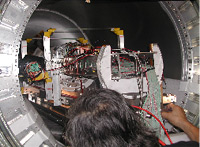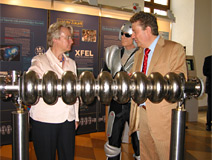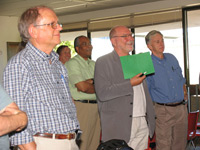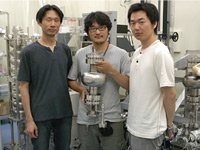 |
|
|
 |
ILC Detectors in the Making: Global Large Detector (GLD)

A TPC field cage, produced by Max Planck Institute, being installed
into a Japanese superconducting solenoid at KEK. |
ILC NewsLine recently provided an overview of the four detector concepts for the International Linear Collider. This week's issue takes a closer look at the Global Large Detector. Stay tuned to ILC NewsLine for future stories about the Large Detector Concept (LDC), Silicon detector (SiD) and the fourth detector concept.
Of the four proposed detector concepts for the International Linear Collider, three of them are based on "particle flow" – a method of precisely measuring the energy of jets. Particle flow algorithms are meant to link the hits in the calorimeter to both charged and neutral particles – just like putting a very complicated puzzle together. Inside the detector the particle showers tend to be repeated and contiguous. Scientists must therefore focus on clearly separating the shower clusters so that the matching of tracks with the clusters can be done unambiguously.
The Global Large Detector (GLD) has the largest calorimeter of 2.1 metres. "The GLD is designed for fine segmentation and optimised for Particle Flow Algorithm (PFA)", said Histoshi Yamamoto of Tohoku University. For a tracker, the GLD uses a Time Projection Chamber (TPC) and for a micro vertex detector, it uses FPCCD, which is based on CCD with super-fine pixels. "The GLD aims to develop a large-scale detector and a detector element of cost effectiveness as an optimisation for the reconfiguration of quark energy," Yamamoto said.
The history of the GLD dates back to the Japan Large Detector (JLD). Similar to the GLD, the JLD has a large inner radius. Based on their experiences with the JLD, the Japanese group thought that a large inner radius would benefit the ILC detector. The GLD detector concept research group based their design on the JLD and optimised detector components for the ILC in internationalising the effort.
Read more...
-- Nobuko Kobayashi |
 |
|
|
 |
|

Last week in Munich, Germany, science was talk of the town. The Euroscience Open Forum - a European version of the AAAS - brought scientists and science media together to talk about the latest news in European research, while the general public had fun during the long night of sciences and a week of 'science summer' in exhibitions, performances, hands-on activities and debates. DESY's cavities at the science summer exhibition attracted a lot of attention, including that of German Federal Minister for Education and Research Annette Schavan, pictured here with a mystery space man and the Director of the German Museum Wolfgang Heckl.
|
|
 |
 |
|
|
 |
View Our Photo Album: VLCW06

(Left to Right) Randy Ruchti, Jim Brau, Herman White, Neil Calder and Ken Olsen participate in one of the exercises during the ILC Communications Workshop, which took place on 18 July. |
You are invited to view our photo album from the first days of the Vancouver Linear Collider Workshop 2006. From Joe Lykken presenting the science case for the ILC to Ken Peach delivering a summary of the recently released European Strategy for Particle Physics, yesterday morning's joint-plenary sessions brought both the ALCPG and GDE together. An important goal from the very beginning for GDE Director Barry Barish, he commended the groups for beginning to take down the traditional barriers between the machine and physics and detector elements of the project. "We are getting better," he said. "We are learning how to bring this together and I hope that eventually the barriers will go away. For now, we have to work very consciously to bring them together."
We're also including some photos from Tuesday's ILC Communications Workshop. After several different group exercises, which involved instantaneous voting with digital keypads on the goals, concerns and strategy for ILC communications, it became clear to the 40 attendees what a challenging yet exciting opportunity lies ahead for us. "It is great that we have so many different kinds of communicators, but it does create a challenge," said Judy Jackson. "It is key that we have a strategic communication plan with a goal, a strategy and a list of tactics that we are going to use to carry this out."
View the slideshow and enjoy!
-- ILC Communicators |
 |
|
|
 |
ICHIRO Cavity and Youths

ICHIRO Cavity and three young scientists (left to right): Daizo Iwai, Juho Hong, and Fumio Furuta. |
On 13 June, an ICHIRO single cell cavity achieved a world record accelerating gradient of 53.5MV/m (megavolts per meter) at KEK.
The traditional design of cavities pays attention to maintaining a low electric field on the niobium surface, while achieving a high accelerating field gradient on the cavity axis. Some scientists believe, however, that the limit could actually be given by the high surface current on the surface of the niobium, which is determined by the surface magnetic field. Kenji Saito of KEK is one of the most outspoken advocates of this conjecture. Based on this belief, KEK co-developed a new shape of cavity with Jacek Sektuwicz of DESY known as the ICHIRO cavity, which is an outgrowth of the Low-Loss (LL) cavity concept that was initially conceived at Jefferson Laboratory.
Read more...
-- Nobuko Kobayashi |
 |
|
|
 |
From The Guardian
18 July 2006
Government shortlists big science builds
The Department for Trade and Industry has announced a shortlist of the next generation of big and expensive science facilities it would like see begin construction over the coming four years.
Read more... |
|
From scenta
17 July 2006
European strategy for particle physics
At a special meeting last Friday in Lisbon, the CERN Council unanimously agreed to adopt a European strategy for particle physics.
Read more... |
|
From Interactions.org
14 July 2006
CERN Council adopts European strategy for particle physics
At a special meeting in Lisbon today, the CERN Council[1] unanimously adopted a European strategy for particle physics. This is an important step for the field, outlining a leading role for Europe in this increasingly globalised endeavour.
Read more... |
|
From Cornell University
July 2006
Jim Alexander named Director for LEPP
Professor Jim Alexander has been named the Director of Cornell University's Laboratory for Elementary-Particle Physics (LEPP), one of the world's leading centers for elementary-particle research.
Read more... |
|
|
 |
 |
|
|
 |
CERN Council Launches European Strategy for Particle Physics

Brian Foster |
Today's issue features a Director's Corner from Brian Foster, GDE European Regional Director.
A new strategy document outlining the future directions for particle physics research in Europe was approved unanimously at a special meeting of the CERN Council in Lisbon on 14 July. Symbolically meeting away from the CERN site, the Council was operating in the mode of a strategic body in which European governments can discuss matters affecting all of European activity in particle physics, which includes, of course, the ILC.
A brief précis of the document could be "steady as she goes". The basic European strategy was set in 2001 by the Foa report, the output of a working group under the then Chair of ECFA, Lorenzo Foa. It gave the highest priority to the completion and proper exploitation of the LHC, and confirmed that what has now become the ILC should be the next major project in particle physics. It also recommended increasing the resources for accelerator physics in Europe both to R&D projects and to education and training. All of these threads, plus some extra ones, notably in astroparticle physics, not considered by the Foa review, can be found in the new CERN strategy statement and accompanying document. Once again, highest priority is given to the completion and exploitation of the LHC and strong support is given both to accelerator physics and R&D, particularly towards neutrino factories and CLIC. While one might have preferred the nuances in some parts, particularly in the accompanying document, to have been slightly different, I am particularly pleased by the strong support that the document voices for the ILC. It is worth quoting the pertinent section in full:
"It is fundamental to complement the results of the LHC with measurements at a linear collider. In the energy range of 0.5 to 1 TeV, the ILC, based on superconducting technology, will provide a unique scientific opportunity at the precision frontier; there should be a strong well-coordinated European activity, including CERN, through the Global Design Effort, for its design and technical preparation towards the construction decision, to be ready for a new assessment by Council around 2010."
This is an even stronger statement than that of Foa and in particular the mandate for CERN to be strongly involved in ILC is very significant. As the construction activity on LHC moves towards completion, technological and engineering know-how should become increasingly available for ILC work, even within the rather severe planned loss of CERN personnel. I have been very gratified by the steadily increasing involvement of CERN personnel in the ILC and look forward to an acceleration of this as foreseen in the new strategy.
Read more...
-- Brian Foster, GDE European Regional Director
Director's Corner Archive |
 |
|
|
 |
|

